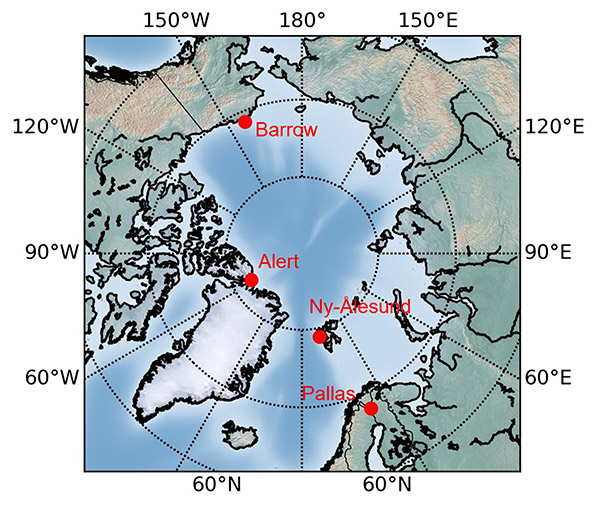National Institute of Polar Research
First standardization of black carbon measurements in the Arctic
Posted on December 17, 2021
Black carbon is a fine-particulate air pollutant, such as soot, that contributes to climate change. It absorbs sunlight, converting it to heat, which can raise temperatures and melt snow and ice. It can also contribute to heart and lung disease in humans. Fortunately, it only persists in the atmosphere for about one week, so any reduction could have an impact on air quality and heating of the atmosphere in a relatively short time.
However, while several instruments in the Arctic measure the mass concentration of black carbon, there has not been a single, standardized examination of their measurements to understand exactly how much black carbon is in the atmosphere until now. An international group of researchers compared black carbon measurements by various light-absorption instruments in the Arctic and found that they were generally highly correlated with the black carbon concentrations measured by COSMOS (continuous soot monitoring system).
They published their results on Oct. 20 in Atmospheric Measurement Techniques.
“Measurements of light-absorbing and light-scattering properties of aerosols are important for constraining their sources, transport and resulting aerosol radiation interactions in the Earth system,” said co-first author Yutaka Kondo, a project professor at the National Institute of Polar Research.
To convert the aerosol absorption coefficients (how much light black carbon particles absorb), to the mass concentrations of black carbon, the conversion factors (the mass absorption cross-section of black carbon) is needed. They can be obtained by dividing the absorption coefficients by the mass concentrations of BC measured by COSMOS.
“However, the accuracy and stability of the mass absorption cross-section have not been fully evaluated, mainly because of a lack of simultaneous and reliable long-term mass concentrations of black carbon in the atmosphere,” Kondo said. “The reliability of the measurements of black carbon concentrations by various types of filter-based absorption photometers in the Arctic was also poorly understood.”
The researchers used COSMOS, which can measure black carbon mass concentration with an accuracy of 15%. According to Kondo, this accuracy is higher than the absorption photometers deployed in Alert, Canada; Utqiaġvik, Alaska; Ny-Ålesund, Svalbard; and Pallas, Finland.

Map showing the locations of Barrow, Alaska; Alert, Canada; Ny-Ålesund, Spitsbergen Island; and Pallas, Finland, where comparative observations of black carbon were made. Credit: Sho Ohata (Nagoya Univ.)
“In this paper, we determined conversion factors to derive black carbon concentrations from the absorption coefficients measured by the seven absorption photometers with accuracies of about 20 to 30% for the first time,” Kondo said, noting the factors depended on the types of the instruments and the locations of the measurements since the relationship between aerosol absorption and concentration can be complicated by co-existing light-absorbing aerosol such as mineral dust.
The conversion factors are further complicated by co-existence of non-black carbon aerosols that influence absorption coefficient by light scattering— however, Kondo said, we have demonstrated high correlation of between the aerosol absorption coefficients and the black carbon concentrations measured by COSMOS at various sites. This correlation provided the reliable conversion factors for the light-absorption instruments.
“Now, we can standardize black carbon data sets obtained so far in the Arctic,” Kondo said. “These data are valuable for understanding the effect of black carbon on the climate in the Arctic. For example, we can validate climate models through comparisons with these data.”
While the standardizing approach works for data obtained in the Arctic, Kondo cautioned that further work is needed before the method can be applied elsewhere in the world.
Original article:
Journal: Atmospheric Measurement Techniques
Title: Estimates of mass absorption cross sections of black carbon for filter-based absorption photometers in the Arctic
Authors:
Sho Ohata (Nagoya University, Japan)
Tatsuhiro Mori (The University of Tokyo, Japan)
Yutaka Kondo (National Institute of Polar Research, Japan)
Sangeeta Sharma (Environment and Climate Change Canada, Canada)
Antti Hyvärinen (Finnish Meteorological Institute, Finland)
Elisabeth Andrews (University of Colorado, US)
Peter Tunved (Stockholm University, Sweden)
Eija Asmi (Finnish Meteorological Institute, Finland)
John Backman (Finnish Meteorological Institute, Finland)
Henri Servomaa (Finnish Meteorological Institute, Finland)
Daniel Veber (Environment and Climate Change Canada, Canada)
Konstantinos Eleftheriadis (National Centre for Scientific Research “Demokritos”, Greece)
Stergios Vratolis (National Centre for Scientific Research “Demokritos”, Greece)
Radovan Krejci (Stockholm University, Sweden)
Paul Zieger (Stockholm University, Sweden)
Makoto Koike (The University of Tokyo, Japan)
Yugo Kanaya (Japan Agency for Marine-Earth Science and Technology, Japan)
Atsushi Yoshida (National Institute of Polar Research, Japan)
Nobuhiro Moteki (The University of Tokyo, Japan)
Yongjing Zhao (University of California, US)
Yutaka Tobo (National Institute of Polar Research, Japan)
Junji Matsushita (National Institute of Polar Research, Japan)
Naga Oshima (Meteorological Research Institute, Japan)
DOI: 10.5194/amt-14-6723-2021
URL: https://doi.org/10.5194/amt-14-6723-2021
Published Online: October 20, 2021
Funding:
The Environment Research and Technology Development Fund (JPMEERF20142003, JPMEERF20152005, JPMEERF20172003, JPMEERF20182003, JPMEERF20202003, and JPMEERF20205001) of the Environmental Restoration and Conservation Agency of Japan, the Japanese Ministry of Education, Culture, Sports, Science and Technology, the Japan Society for the Promotion of Science, the Arctic Challenge for Sustainability (ArCS) project (JPMXD1300000000), the Arctic Challenge for Sustainability II (ArCS II) project (JPMXD1420318865), a grant for the Global Environmental Research Coordination System from the Ministry of the Environment, Japan (MLIT1753), the European Union’s Horizon 2020 research and innovation program, the European Metrology Programme for Innovation and Research, the Academy of Finland, the Swedish Environmental Protection Agency and the U.S. Department of Energy Office of Science’s Atmospheric Radiation Measurement user facility supported this research.








